At 2am on April 22 last year, I departed Chengan Temple (奠安宮) in Changhua County’s Beidou Township (北斗) surrounded by thousands of Matsu devotees. I had endured six days of Jenn Lann Temple’s (鎮瀾宮) Dajia Matsu Pilgrimage (大甲媽祖繞境進香), walking 12 to 14 hours a day and sleeping an average of six hours, most recently in the mosquito-infested inner courtyard of a school. I hadn’t defecated in three days.
At least I was hydrated, having drunk an eight-liter daily ration of water — handed out by generous Matsu devotees along the route — and two large blended fruit juices just before setting out that morning. My bright red, chafed inner thighs forced me to walk with a goofy cowboy-like gait. The blisters on my toes were the size of small grapes.
About three hours outside of Beidou I noticed suddenly that the refreshing juice I’d had earlier was serving as a laxative. With no gas station in sight and all doors shuttered I rushed into a back alley and relieved myself, temporarily forgetting about all my other complaints. More than anything else, the nine-day Dajia Matsu Pilgrimage makes one intensely aware of one’s own body.
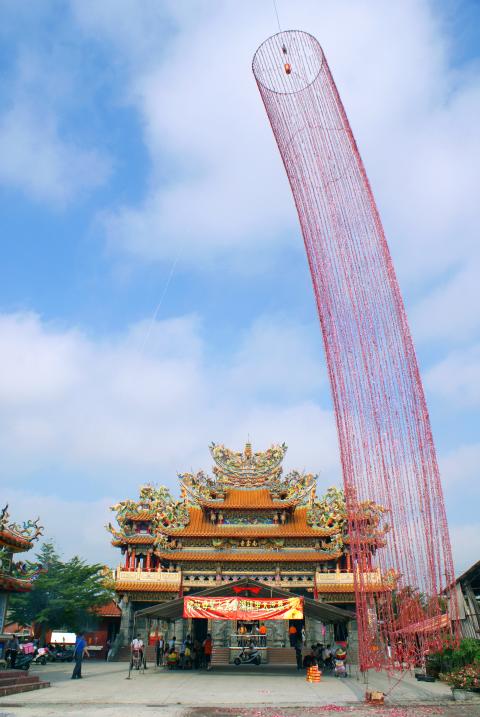
Photo: Noah Buchan, Taipei Times
Dating back to the Qing Dynasty, the Dajia Matsu Pilgrimage is the largest procession of its kind in Taiwan, attracting more than 1 million visitors every year. Pilgrims follow Jenn Lann Temple’s Matsu palanquin for nine days and eight nights along a fixed route from Dajia District (大甲區) in Greater Taichung south to Singang Township (新港) in Chiayi County and back again. The pilgrimage takes place every year in the weeks leading up to Matsu’s birthday, which is on the 23rd day of the third month on the lunar calendar (April 27 this year). This year’s pilgrimage begins tomorrow and ends on April 17.
I traveled, ate and slept together with thousands of other pilgrims (known as “incense guests” (香客) in Chinese). We visited close to a hundred temples altogether. Some people drove, others cycled. Most were, at one time or another, on foot.
The total journey was over 350km.

Photo: Taipei Times
Back on day six of last year’s tour, I cleaned up after myself, checked my map and noted that I’d already visited 60 temples, some more than once. I had slept in a field, below a temple’s incense burner, in a park and on the side of the road. I’d eaten the same vegetarian meal of rice, noodles and porridge and washed it down with plenty of sweet tea and water.
What follows is an anecdotal account of my trip, which began at 11:30pm on Friday, April 17. Tens of thousands of worshippers crowded into Jenn Lann Temple and its large outer square to witness the removal of the Matsu statue and its placement into a lavishly decorated palanquin. To the sounds of blaring horns, booming drums and firecrackers, worshippers rushed to touch the palanquin as a dozen men slowly inched it out of the temple, into the main square and out to the street. The pilgrimage had begun.
Day 1 (Saturday) POWER AND WEALTH

Photo: Noah Buchan, Taipei Times
From Jenn Lann Temple I walk slowly through the neon-lit streets and celebratory atmosphere of Dajia City. Pilgrims and tourists put their hands together in prayer as Matsu’s sedan chair passes. A spirit medium, tongue protruding and eyes rolled back in religious ecstasy, trances slowly behind. The pungent aroma of lit incense and burnt firecrackers fills the air.
We travel south and cross Dajiahsi Bridge (大甲溪橋) into darkness, a few kilometers of humanity walking single file or in groups of up to 10. On the other side of the bridge, we pass through the narrow back streets of rural Greater Taichung toward Dadu District (大肚區), our first rest area six hours away. We will visit five temples on the way.
As with many temple festivals celebrating the birthday of a deity in Taiwan, the Dajia Matsu Pilgrimage has as much to do with displaying the wealth and power of a temple and its organizers as it does showing devotion to a deity.
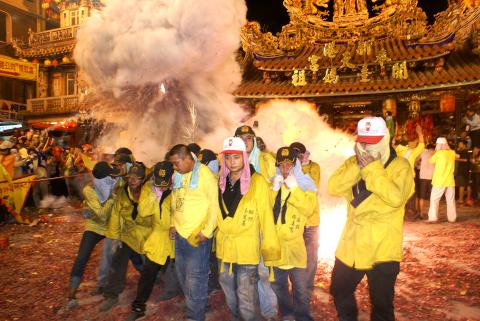
Photo: Noah Buchan, Taipei Times
Yen Ching-piao (顏清標), Jenn Lann Temple’s president and the brains behind the pilgrimage’s spectacular popularity, has wealth and power. Referred to by Jenn Lann Temple as “the throat and tongue of the people,” Yen is thronged by pilgrims and worshippers wherever he makes an appearance. (Some people even reach out to touch him, hoping his good fortune will rub off.)
Yen’s tough grassroots style as a self-made man has led locals to dub him “a small godfather in political circles.” President Ma Ying-jeou (馬英九) and Premier Wu Den-yih (吳敦義) both showed up at Jenn Lann Temple on Friday night to wish pilgrims a healthy journey. Yen even handed Ma a red envelope.
Yen’s reputation could not differ more from Matsu’s hagiography. Whereas Matsu is depicted as scholarly and virtuous, Yen’s larger-than-life resume includes nine months in prison in 2009 on weapons charges stemming from a failed assassination attempt on a rival gangster in 1996. He was sentenced to four years and six months in prison last year for the misuse of public funds. (He has appealed the ruling.) But for local believers, Yen is a generous benefactor who fights for the rights of farmers and fishermen in central Taiwan, where he is a legislator and power broker.
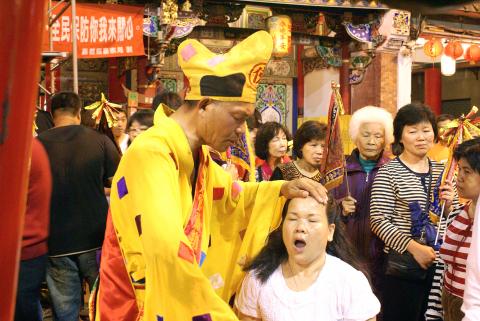
Photo: Noah Buchan, Taipei Times
At roughly 7am, Yen emerges from a black SUV and saunters over a hill close to his home in Shalu District (沙鹿區) with a retinue of heavily tattooed youths in tow. Following an astounding pyrotechnical display that takes up several lanes of traffic and lasts about 20 minutes, Yen mingles with the faithful at a makeshift canteen.
I feast on a breakfast of congee and soya milk, rest for an hour on a retaining wall and move on toward our next destination: Tienhou Temple (天后宮) in Beidou Township, 24 hours away.
Day 2 (Sunday) WALK, BIKE OR DRIVE

Photo: Noah Buchan, Taipei Times
The densely populated area around Dajia City has given way to grids of verdant green rice patties. The pilgrimage line follows a similar pattern. We were squeezed together when we first started, but now everyone walks at their own pace. The pilgrimage line stretches for several kilometers. We pass factories of various sizes during the day, occasionally resting in a park or at the side of the road. I sleep a few hours under a boxy concrete structure, its awning shading me from the sun.
Scooters, trucks, bicycles and carts — any and all mode of transportation is used to complete the pilgrimage. Veteran pilgrims, however, say that walking is the only way to go.
Later when I reach Tienhou Temple, I encounter a cycling group resting in the cool shade of the temple courtyard. Hsiung Wang-chi (熊汪池), the group’s leader, has organized the tour for the past four years. Each of the 120 riders have paid NT$1,900 for the opportunity to cycle the pilgrimage route.
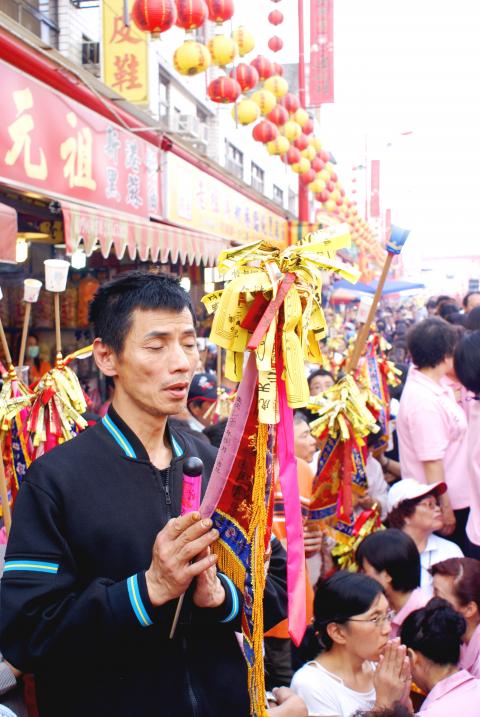
Photo: Noah Buchan, Taipei Times
“Not everyone has the energy to walk the entire journey,” Hsiung tells me. “Besides, cycling keeps us ahead of the pack.”
As Hsiung bikes away, he asks why I’m not carrying an “incense flag.”
“You’re not a true pilgrim if you don’t have one,” he shouts back.
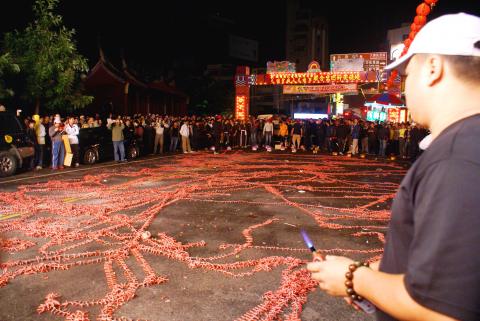
Photo: Noah Buchan, Taipei Times
Immediately after Hsiung departs, a pilgrim, who had been eyeing me since I arrived, wanders over and says that riding a bike is a sacrilege.
“They aren’t suffering enough,” she spits out. “Walking is the only way to show the proper respect [to Matsu], who will offer you blessings in return.” She nods her approval at me, as I am obviously on foot.
But I’m too distracted with what Hsiung had just told me to pay attention to the woman. “True pilgrims” need to carry “incense flags”? How have I been walking for two days without noticing? A quick look around confirms that almost everyone in sight has a triangular yellow flag.
For me, anyone willing to walk, drive or cycle the nine days should be counted a “true pilgrim,” regardless if they are on foot or not. And by the end of the second day, my overloaded pack would be much easier to transport on a bike. Hsiung and his gang of cyclists look pretty intelligent, if less than fanatically devotional.
I decide that I must get to the bottom of this incense flag business and become a “true pilgrim,” but only after a few hours of sleep.
Day 3 (Monday) FLAGS AND TALISMANS
“Do you know where I can get one of those?” I ask a man surnamed Huang, pointing to his incense flag.
We are standing in front of Lungtzu Temple (隆玄宮) on a cloudless and hot afternoon. The owner of a car parts business in Taipei, Huang has outfitted a large truck to sleep and feed 10 of his 20 employees, as well as much of his extended family. It’s his fourth year doing so.
“Of course,” he replies. “Jenn Lann Temple.”
That would mean retracing my steps for the first three days of the pilgrimage, an impossible prospect. Can I get a second-hand flag, perhaps from another pilgrim who doesn’t want it?
“Nobody would dare disrespect Matsu in such a way,” he says. Huang, like most of the pilgrims I meet on the route, is very patient in answering what must seem to him idiotic questions. As we walk up to Lungtzu Temple, he explains the flag’s purpose.
Before setting out, pilgrims buy a triangular yellow flag, colorfully emblazoned with dragons and Taoist religious symbols, from Jenn Lann Temple.
“When you arrive at any temple along the route, you have the flag stamped with the temple’s chop and pick up a fu (符, talisman), which you tie to the incense flag with this red string,” Huang says.
He brings me over to the temple’s main censer, which is puffing out incense, and waves his flag through the smoke three times to absorb the temple’s qi (energy or power).
The process, Huang says, is repeated with every temple visited. The more talismans affixed to the flag, the greater its spiritual power. The flag serves as a kind of auspicious map of the temples a pilgrim has visited.
By evening I’ve manage to purchase an incense flag (NT$350) at Singang’s Fengtien Temple (奉天宮), which pilgrims tell me is the only other temple on the route where they can be acquired. After paying, I dutifully affix paper talismans to the flag that I began to collect after hearing Huang’s explanation.
Day 4 (Tuesday) MATSU, GODDESS OF THE SEA
Fengtien Temple in Singang is more than just your average temple. With its parks, shops, and open spaces for all manner of traditional performances, it’s a textbook example of how social, cultural and economic life gather around a temple. I’ve taken advantage of a grassy park and caught a few hours sleep, with a tent to my left and a family resting on a flattened cardboard box to my right.
Fengtien Temple is the southernmost point of the pilgrimage, and after two nights pilgrims will begin the return journey to Jenn Lann Temple in Dajia. The journey down is a rather solemn affair, symbolized by expectations that the devout abstain from alcohol and sex. While in Singang, temple officials go through all manner of chanting, praying and worshipping to give thanks to Matsu’s benevolence, and performance troupes entertain the faithful.
The purpose of the pilgrimage is simple: Jenn Lann Temple’s Matsu statue is brought out of her resting place once a year to “inspect” (繞境) her territory, which consists of temples related ritually or through personal networks to Jenn Lann.
Months before the pilgrimage begins, organizers decide on a fixed route. Temple operators vie to be chosen because it raises their profile in their community and, through massive media attention, nationally. Temples that are left out sometimes feel cheated and even try to “kidnap” Matsu’s sedan chair (see day 7).
As with the pilgrimage itself, the cult of Matsu is the stuff of legend. Though accounts vary, she was born into a humble family. She is said to have mastered the Confucian classics and demonstrated a flair for banishing evil and averting disasters — particularly those involving the dangerous waters of the Taiwan Strait, hence her current status as goddess of the sea and protector of fishermen and sailors.
The various names attributed to Matsu throughout history — shaman (巫), filial lass, celestial consort (天妃), celestial empress (天后), avatar of Guanyin (觀音), divine matriarch in heaven above (天上聖母) and, in the past few years, goddess of cross-strait peace — illustrate her rise from local healer to a pan-Chinese cultural symbol with elements of Confucianism, Buddhism and Taoism. Most commonly, the devout call her simply Matsu (媽祖), or female ancestor.
Having spent over a day at Singang resting, eating and giving thanks to Matsu, we set out on our return journey. We depart the Fengtien Temple after midnight. Like all important stops along the route, an early morning departure is chosen because it is deemed the most auspicious.
Day 5 (Wednesday) TABOOS
Emerging from Singang on a back road north toward Huwei (虎尾) Township, I’m gloating like an arrogant child who has just won first prize in an etiquette contest, triumphantly carrying my incense flag and its lucky charms. I walk with renewed energy because, with my aching body and recently acquired flag, I’m now a “true pilgrim.”
And the devout have taken notice: As our pilgrimage line ambles throughout the night and into the early morning, my fellow pilgrims rush over with bottles of water. Performance troupes offer me betel nuts and swigs of fiery alcohol from gourd-shaped flasks. I’m constantly stopped and bombarded with questions of where I come from and why I’m on the road. As a show of respect to Matsu, I say, and by extension Taiwan.
But with rights come responsibilities, as I learn when I’m approached by a middle-aged woman surnamed Lee.
“You aren’t supposed to be affixing the paper talismans to the flag on the [return trip],” she huffs in a schoolmarm voice as I emerge from Tehsing Temple (德興宮), located at the end of an alley surrounded by one-story brick homes.
Lee has lived in the US for 20 years and returned to Taiwan to participate in the pilgrimage, “something that every Taiwanese should do at least once in their life,” she says.
She says that on the way down to Singang, pilgrims go to every temple, stamp their flag, pick up their talisman and proceed along the fixed route. On the way back, however, the flag should be carefully wrapped in plastic to protect it from the elements.
“Do you have an altar at home?” she asks. I try to mumble my “no” response in Chinese (沒有) to make it sound as much like “yes” (有) as possible. Lee is not fooled. She tells me that upon my return home, I must fashion an altar and place the flag there.
“And where is your incense?” she commands.
Incense?
Lee says “real pilgrims” carry lit incense throughout the entire nine-day journey. She pulls a few sticks from her rucksack and hands them to me.
The fact that I’m breaking a number of taboos makes Lee chatty. As we talk, I rest my flag on the ground. Nope, Lee says, the flag shouldn’t touch the ground.
She removes a plastic bag to wrap up my flag, which I allow her to do, though I remove it later after we separate. When I tell her I have to go to the bathroom, she tells me not to bring the flag inside. I ask if she will hold the flag while I take care of my business, which brings a scoff that nobody else is to touch the flag except me.
After Lee’s chastising, I’m somewhat despondent. I leave her and walk the next six hours with my head down. Later the few hours of sleep I catch under an incense censer are interrupted by bad dreams and falling ashes from lit incense held by worshippers, burning my exposed legs.
Day 6 (Thursday) PERFORMANCE TROUPES
After five days of walking and having yet to recover from Lee making me feel like a fraud, I move to catch up to Matsu’s sedan chair in the hopes of having it pass over me for good luck and to revive my spirits.
Crawling under Matsu’s sedan chair is de rigueur and is believed to bring luck to those who do so. On the return journey, it is not uncommon to see a kilometer-long line of prostrate worshippers waiting for this honor. Though I cannot see it, the distant sounds of blaring horns and beating drums, which mark out Matsu’s arrival at a temple, serve as an auditory beacon.
As I race to catch up, I encounter a performance troupe dressed in yellow uniforms that I’ve been chatting with on and off throughout the trip. As they see me approach, one member dressed as a spirit medium wanders up, and seeing my look of despondency, he uncorks a flask filled with whisky.
These troupes, some hired by Jenn Lann Temple, others voluntary, range from the 36 Weapons Brigade (3十6執士) who precede Matsu’s palanquin (to protect her from ghosts) to scantily clad female dancers strutting their stuff on the back of trucks (presumably to entertain the pilgrims). In between there are the eight generals (八家將), martial lictors, wandering spirit mediums, electric cars and lion dance troupes.
Lesser known, though equally visible, are the scores of Criminal of Investigation Division (CID) officials and police officers who walk alongside Matsu’s sedan chair and direct traffic away from the long pilgrimage line.
As I approach Matsu’s palanquin, these crowd controllers, along with Jenn Lann Temple “guards,” are doing their harried best to organize a long row of prostrate worshippers into a single file. I take my place at the end, crouch down behind an elderly man and wait for the Matsu’s sedan chair to pass over me. After it does, I feel refreshed and ready to continue my journey, my previous doubts of authenticity fading after Matsu’s blessing.
Day 7 (Friday) TERRITORIAL DISPUTES
Soon I’ll be entering Changhua City (彰化). Pilgrimage lore has it that the first, fourth and final days are the most spectacular due to the huge numbers of pilgrims and tourists who turn out. This may be true, but to gain a real sense of the pilgrimage, day seven in Changhua is not to be missed.
Changhua is said to have the most passionate Matsu believers — and, pilgrims say, a large number of hoodlums and gangsters. These young toughs compete with each other to stall Matsu’s sedan chair in their “territory” — roughly one-third of a city block — for as long as possible. Doing so, they believe, increases their spiritual power, drives away ghosts and increases prosperity over the coming year.
They accomplish this by the strategic setting off of large amounts of fireworks and firecrackers. When set off, the fireworks dramatically hinder the movement of Matsu’s palanquin, leading to a number of logistical nightmares. Matsu is, after all, on a tight schedule. The longer she spends in one territory, the less time she has for another. As tons of fireworks are let off — some at street level, others from the hands of pilgrims or off the back of a tractor-trailer — arguments erupt between young men, who scream at each other to let Matsu pass.
It is also in Changhua that Matsu’s sedan chair has been kidnapped by spirit mediums. Snubbed by Dajia Matsu Pilgrimage organizers, these devotees have been known to rush the palanquin, forcefully take it from the bearers and carry it to their own temples, where they keep it for as long as possible so as to increase their temple’s spiritual power. This probably explains the increased police presence in the area.
Though there are many starts and stops, arguments and curses, fireworks and firecrackers, Matsu’s sedan chair eventually makes its way toward Tienhou Temple (天后宮) in the city center, and I get some much-needed sleep.
Day 8 (Saturday) FREE FOOD AND SMILES
Following the frenzy of downtown Changhua, we hit open road at 3am and walk for the next five hours until we reach Tienhou Temple in Wangtien Village (王田) for breakfast. Along the road leading up to the temple, the devout turn out in full so as to give offerings to pilgrims — just as they’ve done throughout the entire journey.
The liberal dissemination of beverages (water, tea, drink boxes, beer and cola), food (noodles, rice, buns, fruit and candy) and ritual objects (incense and talismans) — all for free and with a smile and a jiayou (加油) — marks Matsu devotees as incredibly altruistic.
I ask a farmer handing out large wedges of watermelon how he prepares so much and why he is so generous.
“It’s not me who is generous. It is Matsu,” he says, passing me two bottles of water.
“Her blessings are the reason why I have so much to give,” he adds.
I have learned throughout the previous eight days that if you are frugal and well prepared (sleep outside, avoid extravagances), you can finish the entire nine-day trip with under NT$1,000 (though small donations to temples along the way are hoped for).
Day 9 (Sunday) ARRIVAL
As I cross the final bridge back into Dajia in the late afternoon — 4kg lighter, my skin tanned a toffee brown — I witness streets packed full of tourists. I ask a police officer for an estimate. “More than 200,000,” he says, a number that will certainly double after sundown as Matsu’s sedan chair returns to her resting place inside Jenn Lann Temple.
Though I didn’t come back a full Matsu believer, the generosity shown by my fellow pilgrims and devotees on the way has made the entire journey worthwhile.

With the inauguration of the Democratic Progressive Party’s (DPP) William Lai (賴清德) today, the DPP has already announced plans for increased social spending. Meanwhile the Chinese Nationalist Party (KMT) is pushing east coast infrastructure spending bills through the legislature, in part to feed and water its local patronage networks. The KMT plan is old: the first planning studies for it were done in 2012 under the Ma Ying-jeou (馬英九) administration. Even then the head of the highway administration, Wu Meng-feng (吳盟分), pointed out that on a typical weekday only 20 percent of the capacity of the east coast highways 9

Gaotai Mountain (高台山) and the three Daotian Peaks (小中大島田山回來) afford visitors a truly rewarding hike in Hsinchu County (新竹). Located in the foothills just beyond the charming Neiwan Old Street (內灣老街), the hike is well suited for hikers in a fair to good physical condition. It’s also a good introduction to the foothills of northwest Taiwan, along with some more adventurous — but still not terribly dangerous — rope and scrambling sections. As a bonus, there are Japanese ruins, hot springs and river tracing destinations such as Meihua Waterfall (梅花瀑布) and Bilin Waterfall (比麟瀑布) all located nearby. WHISPERING PINES The first section of

Like many young Taiwanese men who recently graduated from university, George Lee (李芳成) isn’t quite sure what he’ll do next. But some of his peers surely envy what he’s already achieved. During the pandemic, while staying with his brother in California, Lee started an online food page, Chez Jorge. At first, it was a straightforward record of what he cooked each day, with many of the dishes containing meat. Lee soon began to experiment with plant-based dishes, specifically vegan versions of Taiwanese dishes he was already familiar with. “Very often, I found myself awed by not only how delicious they were,

May 20 to May 26 The two American HU-16 seaplanes hovered helplessly above the roaring waves, unable to save their seven comrades who had parachuted into the Pacific Ocean after their plane malfunctioned. As they were discussing the next plan of action over the airwaves, a Taiwanese plane overheard the conversation and told them to contact Chin Moon Fun (陳文寬) — “because that guy can land a plane on any water surface!” On March 18, 1954, Chin, who co-owned Foshing Airlines (復興航空, renamed TransAsia in 1992), hurriedly flew one of the company’s two amphibious PBY Catalina planes to the scene. Even though